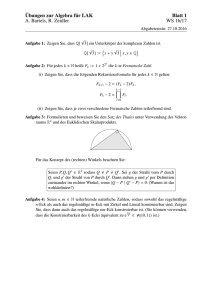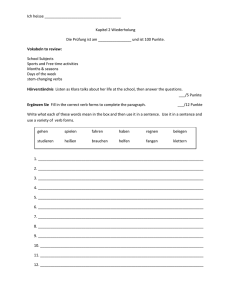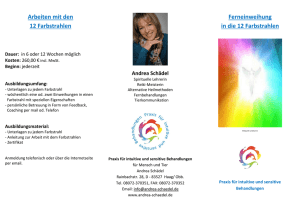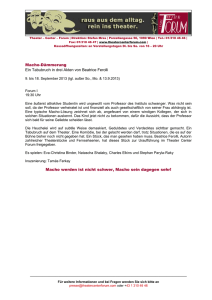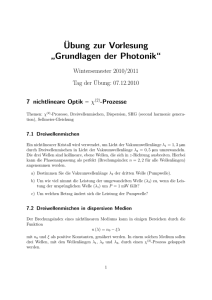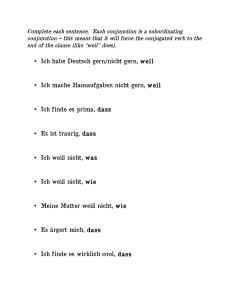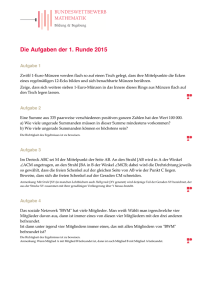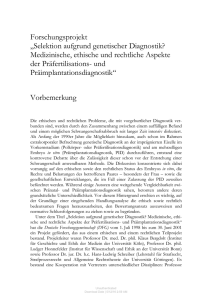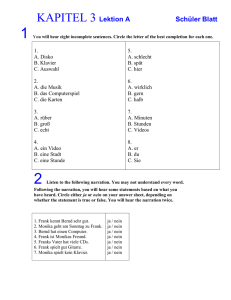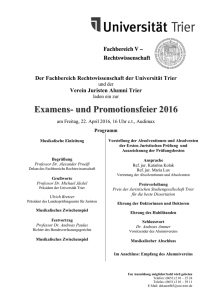Name
Werbung
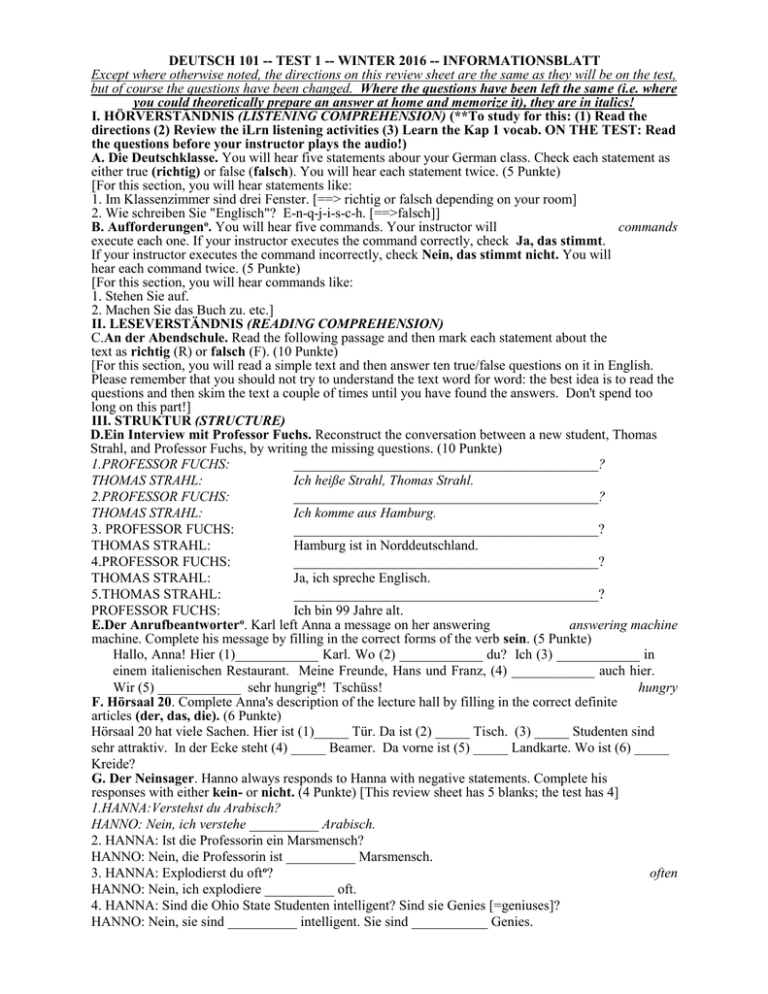
DEUTSCH 101 -- TEST 1 -- WINTER 2016 -- INFORMATIONSBLATT Except where otherwise noted, the directions on this review sheet are the same as they will be on the test, but of course the questions have been changed. Where the questions have been left the same (i.e. where you could theoretically prepare an answer at home and memorize it), they are in italics! I. HÖRVERSTÄNDNIS (LISTENING COMPREHENSION) (**To study for this: (1) Read the directions (2) Review the iLrn listening activities (3) Learn the Kap 1 vocab. ON THE TEST: Read the questions before your instructor plays the audio!) A. Die Deutschklasse. You will hear five statements abour your German class. Check each statement as either true (richtig) or false (falsch). You will hear each statement twice. (5 Punkte) [For this section, you will hear statements like: 1. Im Klassenzimmer sind drei Fenster. [==> richtig or falsch depending on your room] 2. Wie schreiben Sie "Englisch"? E-n-q-j-i-s-c-h. [==>falsch]] B. Aufforderungeno. You will hear five commands. Your instructor will commands execute each one. If your instructor executes the command correctly, check Ja, das stimmt. If your instructor executes the command incorrectly, check Nein, das stimmt nicht. You will hear each command twice. (5 Punkte) [For this section, you will hear commands like: 1. Stehen Sie auf. 2. Machen Sie das Buch zu. etc.] II. LESEVERSTÄNDNIS (READING COMPREHENSION) C.An der Abendschule. Read the following passage and then mark each statement about the text as richtig (R) or falsch (F). (10 Punkte) [For this section, you will read a simple text and then answer ten true/false questions on it in English. Please remember that you should not try to understand the text word for word: the best idea is to read the questions and then skim the text a couple of times until you have found the answers. Don't spend too long on this part!] III. STRUKTUR (STRUCTURE) D.Ein Interview mit Professor Fuchs. Reconstruct the conversation between a new student, Thomas Strahl, and Professor Fuchs, by writing the missing questions. (10 Punkte) 1.PROFESSOR FUCHS: ____________________________________________? THOMAS STRAHL: Ich heiße Strahl, Thomas Strahl. 2.PROFESSOR FUCHS: ____________________________________________? THOMAS STRAHL: Ich komme aus Hamburg. 3. PROFESSOR FUCHS: ____________________________________________? THOMAS STRAHL: Hamburg ist in Norddeutschland. 4.PROFESSOR FUCHS: ____________________________________________? THOMAS STRAHL: Ja, ich spreche Englisch. 5.THOMAS STRAHL: ____________________________________________? PROFESSOR FUCHS: Ich bin 99 Jahre alt. E.Der Anrufbeantwortero. Karl left Anna a message on her answering answering machine machine. Complete his message by filling in the correct forms of the verb sein. (5 Punkte) Hallo, Anna! Hier (1)____________ Karl. Wo (2) ____________ du? Ich (3) ____________ in einem italienischen Restaurant. Meine Freunde, Hans und Franz, (4) ____________ auch hier. Wir (5) ____________ sehr hungrigo! Tschüss! hungry F. Hörsaal 20. Complete Anna's description of the lecture hall by filling in the correct definite articles (der, das, die). (6 Punkte) Hörsaal 20 hat viele Sachen. Hier ist (1)_____ Tür. Da ist (2) _____ Tisch. (3) _____ Studenten sind sehr attraktiv. In der Ecke steht (4) _____ Beamer. Da vorne ist (5) _____ Landkarte. Wo ist (6) _____ Kreide? G. Der Neinsager. Hanno always responds to Hanna with negative statements. Complete his responses with either kein- or nicht. (4 Punkte) [This review sheet has 5 blanks; the test has 4] 1.HANNA:Verstehst du Arabisch? HANNO: Nein, ich verstehe __________ Arabisch. 2. HANNA: Ist die Professorin ein Marsmensch? HANNO: Nein, die Professorin ist __________ Marsmensch. 3. HANNA: Explodierst du ofto? often HANNO: Nein, ich explodiere __________ oft. 4. HANNA: Sind die Ohio State Studenten intelligent? Sind sie Genies [=geniuses]? HANNO: Nein, sie sind __________ intelligent. Sie sind ___________ Genies. H. Die Deutschklasse. Complete the following sentences you overhear in your German class. Use the correct pronoun (er, es, sie). (5 Punkte) 1. Hier ist die Professorin. _____ ist intelligent, athletisch, modern, kompetent, kreativ und freundlich. 2. Sind die Stühle elegant? Ja, _____ sind beige und superelegant. 3. Welche Farbe hat der Tisch? _____ ist braun. 4. Warum ist das Baby hier? _____ ist ein Genieo. genius 5. Ist die Tafel rot? Nein, _____ ist schwarz. IV. VOKABELN (VOCABULARY) I.Gegenteileo. Max and Moritz are always contradicting each other. Complete their opposites statements with a word that has the opposite meaning of the italicized word. (5 Punkte) 1.MAX: Ich finde Professor Schimmel unattraktiv. MORITZ: Ach, nein! Ich finde Professor Schimmel ______________________. 2.MORITZ: Mein Haar ist dunkelbraun. MAX. Nein! Dein Haar ist ________braun. 3.MAX: Justin Bieber ist alt. MORITZ: Das stimmt nicht! Der Biebs ist ______________________. 4.MORITZ: Du bist schlank. MAX: Unsinn! Ich bin ____________________. 5.MAX: Arnold Schwarzenegger ist __________________________. MORITZ: Das stimmt nicht! Arnold ist groß. J. Mathematikaufgaben. Help Frank with his math homework. Spell out the answers to each of the following math problems. (5 Punkte) Beispiel: Sechs plus sechs ist zwölf example 1. siebzehn plus vierzehn ist 2. Sechsunddreißig plus sieben ist 3. Zehn minus zehn ist 4. Dreiundzwanzig minus elf ist 5. Siebenundsiebzig minus dreizehn ist K. Was ist logisch? Complete the following sentences with a word that fits logically. (5 Punkte) (5 Punkte) Beispielo: Das Buch heißt Vorsprung. example 1 . Die deutsche Flagge ist schwarz, __________________ und __________________. 2. Wir ___________________________ das Buch. [We won't put this verb on the test, but you know it!] 3. SPAM® ist nicht lila. SPAM® ist __________________________. 4. Anna fragt und die Professorin ______________________. [Not on vocab list, but see p. 12!] V.KULTUR (CULTURE) *Based on Vorsprung only, not the online text(s)!* L.Was ist logisch? Circle the item that best answers a question or completes a statement about the German-speaking countries. (5 Punkte) [5 questions, two of which are below. Read Brennpunkt Kultur p. 11, 16 & 32 & In der Deutschklasse!] 1. Once inside the shop, what pronoun would you use to address the three clerks working there? One clerk is in his sixties, the other two are in their twenties, and you're talking to all 3 of them at once. a. sie c. du b. Sie d. ihr 2. What is the approximate number of German native speakers in Europe? a. Less than 20 Million b. 30-40 Million c. 100-130 Million d. 170-200 Million VI. ZUM SCHREIBEN (WRITING) M.Der Student/Die Studentin im Deutschkurs. In five (or more) sentences, describe a classmate in your German class. Include your classmate's name, age, nationality, where he/she comes from, and a physical description, e.g., eye color, hair color and length. (20 Punkte)
